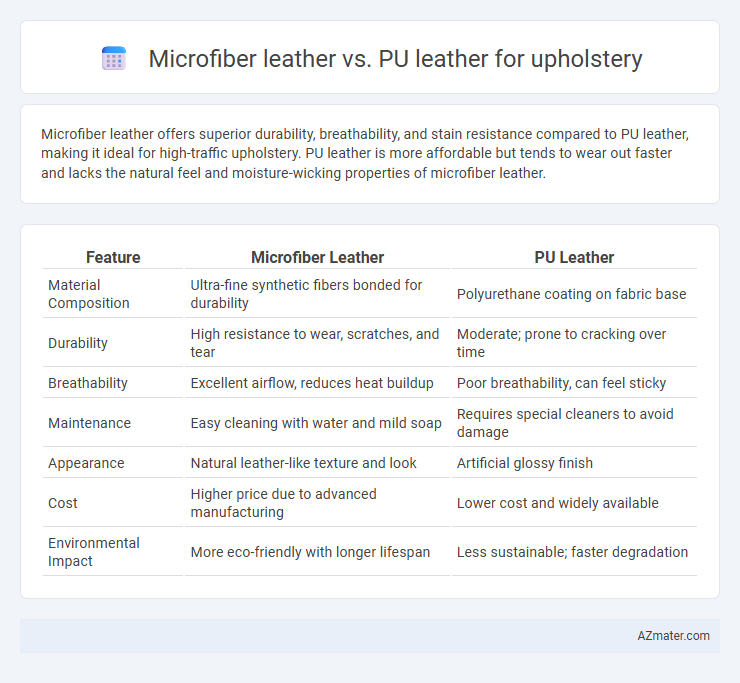Microfiber leather offers superior durability, breathability, and stain resistance compared to PU leather, making it ideal for high-traffic upholstery. PU leather is more affordable but tends to wear out faster and lacks the natural feel and moisture-wicking properties of microfiber leather.
Table of Comparison
| Feature | Microfiber Leather | PU Leather |
|---|---|---|
| Material Composition | Ultra-fine synthetic fibers bonded for durability | Polyurethane coating on fabric base |
| Durability | High resistance to wear, scratches, and tear | Moderate; prone to cracking over time |
| Breathability | Excellent airflow, reduces heat buildup | Poor breathability, can feel sticky |
| Maintenance | Easy cleaning with water and mild soap | Requires special cleaners to avoid damage |
| Appearance | Natural leather-like texture and look | Artificial glossy finish |
| Cost | Higher price due to advanced manufacturing | Lower cost and widely available |
| Environmental Impact | More eco-friendly with longer lifespan | Less sustainable; faster degradation |
Introduction to Upholstery Materials
Microfiber leather and PU leather are popular upholstery materials known for durability and easy maintenance. Microfiber leather consists of tightly woven synthetic fibers, offering breathability and resistance to scratches, making it suitable for high-traffic furniture. PU leather, a synthetic leather made from polyurethane, provides a smooth, leather-like appearance and water resistance but may be less breathable compared to microfiber.
What is Microfiber Leather?
Microfiber leather is a high-performance synthetic material composed of ultra-fine polyurethane fibers woven tightly to create a durable, breathable fabric resembling genuine leather. It offers superior resistance to wear, stains, and moisture compared to traditional PU leather, making it ideal for upholstery in high-traffic environments. This innovative material also provides enhanced softness and flexibility, combining comfort with long-lasting durability in furniture applications.
What is PU Leather?
PU leather, also known as polyurethane leather, is a synthetic material made by coating a base fabric, typically polyester or cotton, with a layer of polyurethane polymer that mimics the appearance and texture of genuine leather. It offers water resistance, easy maintenance, and affordability compared to real leather, making it a popular choice for upholstery in furniture and automotive interiors. PU leather's durability and flexibility provide a practical and eco-friendly alternative, although it may lack the breathability and aging qualities of natural leather.
Durability: Microfiber vs PU Leather
Microfiber leather offers superior durability compared to PU leather due to its dense microfiber structure, which resists wear, scratches, and abrasions over time. PU leather tends to crack and peel faster, especially with frequent use and exposure to heat or moisture. This makes microfiber leather a more resilient and longer-lasting choice for upholstery applications.
Comfort and Texture Comparison
Microfiber leather offers superior breathability and softness compared to PU leather, making it more comfortable for upholstery use. Its finely woven synthetic fibers create a suede-like texture that feels smooth and luxurious, while PU leather tends to have a stiffer and less breathable surface. The durability of microfiber leather also maintains its texture over time, enhancing long-term comfort and aesthetic appeal.
Water and Stain Resistance
Microfiber leather exhibits superior water and stain resistance compared to PU leather due to its dense fiber structure and hydrophobic coating, preventing liquid absorption and facilitating easy cleaning. PU leather tends to absorb spills more readily, leading to quicker staining and potential material degradation over time. For upholstery applications demanding durability and maintenance ease, microfiber leather offers enhanced protection against everyday wear and moisture exposure.
Maintenance and Cleaning Requirements
Microfiber leather offers superior resistance to stains and water, making it easier to clean with just a damp cloth, which reduces the need for harsh chemicals or frequent maintenance. PU leather requires more careful upkeep to prevent cracking and peeling, often needing specialized cleaners and conditioners to maintain its appearance. Both materials benefit from regular dusting, but microfiber leather's durability and low-maintenance nature make it ideal for busy environments.
Environmental Impact and Sustainability
Microfiber leather outperforms PU leather in environmental impact due to its production process, which uses fewer harmful chemicals and less water, reducing overall pollution. Unlike PU leather, which relies heavily on non-renewable petroleum-based materials and releases toxic byproducts during manufacturing and disposal, microfiber leather incorporates synthetic fibers that are more durable and often recyclable. Sustainable upholstery choices prioritize microfiber leather as it offers longer lifespan and lower carbon footprint, aligning better with eco-friendly consumer demands.
Cost Comparison: Microfiber vs PU Leather
Microfiber leather typically costs more than PU leather due to its superior durability and natural leather-like texture, making it a longer-lasting investment for upholstery. PU leather offers a more budget-friendly option with a lower initial price but may wear out faster and require more frequent replacement. Choosing between microfiber and PU leather depends on balancing upfront cost with long-term value and maintenance needs in upholstery applications.
Best Applications for Each Material
Microfiber leather excels in high-traffic upholstery settings such as office chairs and automotive seats due to its superior durability, stain resistance, and breathability. PU leather is ideal for decorative furniture like sofas and accent chairs where affordability and a wide variety of colors and textures are desired, though it offers less breathability and longevity compared to microfiber leather. Selecting microfiber leather supports long-term performance in commercial environments, while PU leather suits budget-conscious projects emphasizing aesthetic versatility.

Infographic: Microfiber leather vs PU leather for Upholstery
 azmater.com
azmater.com